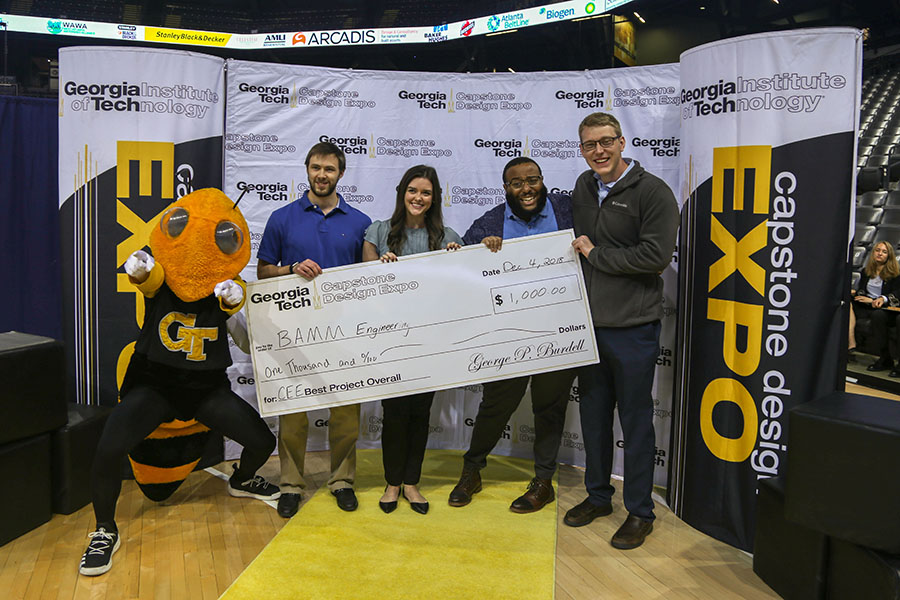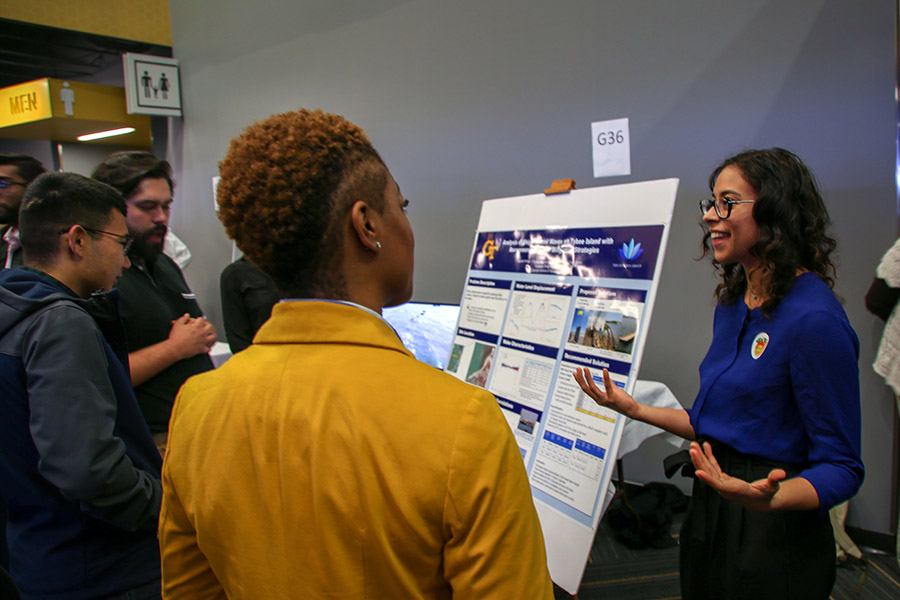 The BAMM Engineering senior design team won top prize among the 18 civil and environmental engineering groups at the fall 2018 Capstone Design Expo Dec. 4. The Georgia Department of Transportation asked them to develop a different approach to rerouting traffic along 13 miles of Interstate 20 in West Georgia for a reconstruction and widening project. Officials saw a spike in crashes and fatalities in the first year of the project and wanted to consider new ideas. Team members with Buzz at the expo awards ceremony: Michael Nieman, left, Bailey Little, Andrew White and Matthew Gruba. (Photo: Amelia Neumeister) |
The Georgia Department of Transportation shut down work on a 13-mile stretch of Interstate 20 earlier this year after officials noticed a spike in crashes and roadway fatalities in the area.
The agency made some changes to their construction staging and resumed work, but the situation offered an opportunity for Georgia DOT to ask: How could traffic rerouting and construction staging have been handled better?
That became the basis for the top civil and environmental engineering senior design project at the fall 2018 Capstone Design Expo Dec. 4.
The winning team, BAMM Engineering, came up with a way to eliminate one of the six phases of staging and avoid routing eastbound traffic temporarily onto the westbound lanes of I-20. Their solution, which included adding a new 15-foot-wide shoulder for traffic to use, ended up costing almost the same as the original budget.
“It felt like we were team brought in as outside experts [and told,] utilize all your knowledge to solve this very vague, complex but also, paradoxically, very specific problem,” said Andrew White, a civil engineering major who’ll graduate in May. “They have a goal that they’re trying to reach, and we just had to help them try to reach that goal.”
His teammate Bailey Little said the experience gave her new appreciation for the competing interests GDOT must balance.
“I have a respect for their decision-making process and, I think, a new understanding of it,” Little said. “It’s easy for us to say, ‘Hey that was a terrible idea’ now that we know [what happened.]”
The team, which also included civil engineering seniors Michael Nieman and Matthew Gruba, was one of 18 senior design teams from the School of Civil and Environmental Engineering at the fall expo. Other teams created designs for a fueling pier in Japan and a plan for battling erosion on Tybee Island from container ship traffic. They offered suggestions for routing the northwest portion of the Atlanta Beltline, and they tackled one of Atlanta’s notorious bottlenecks — the “Brookwood split” where interstates 75 and 85 diverge north of downtown.
 Ashton Austin and Alex Herdt talk about their ideas for improving the Brookwood split — where interstates 75 and 85 diverge north of Atlanta. The team worked to ease congestion in the area and ultimately offered a combination of changes — all still within the existing right of way — that would significantly reduce crashes and save drivers' a total of 3,100 hours daily. (Photo: Amelia Neumeister) |
“[Our] 75-south-to-85-north ramp change will cut out about three minutes of travel time; the Buford-Spring could shave off, depending on what path you’re taking, about two minutes, which is pretty significant in this area, considering all the constraints that you have,” said civil engineering senior Madison Dorminey.
“There’s really not a lot of room for a total redesign, but three minutes, two minutes, 3,100 hours total is a significant impact on this interchange.”
Team Dorminey & Sons — the sons, apparently, are team members Alex Herdt, Ashton Austin and Andrew Lewis — project their improvements could save drivers up to 3,100 hours per day in total and reduce crashes by more than 80 percent by eliminating the loop where 75 southbound curls around to join 85 northbound.
Spencer Maddox and his group worked on plotting a possible route for the Atlanta Beltline’s northwest corridor.
“It was really cool to do, and it was also really cool that we were the first group to ever touch this stuff,” said Maddox, who will graduate in May and move into the BS/MS program. “[The Beltline hasn’t] hired any consultants; nobody else has even really looked at this, so just to think that even sections of our alignments could be chosen for the final is just really cool.”
 Civil engineering undergraduate Diana Sacks, right, talks about her senior design project during the Capstone Design Expo Dec. 4. The Eurybia Group team had to design an energy-dampening system to protect the Tybee Island shoreline from the wake caused by container ships entering the Savannah River. Sacks, Vincent Harvey, Christian Mosely and Melissa Osgoodby proposed rehabilitating a century-old existing jetty to their sponsor, the U.S. Army Corps of Engineers. (Photo: Amelia Neumei |
Christopher Skretkowicz and team CJMS Inc. analyzed the feasibility of using timber instead of steel and concrete to build a 22-story building at Tech Square.
“It seems to be the big rage these days, mass timber. It’s the building style of the future,” said Skretkowicz, who’s finishing his bachelor’s in civil engineering this month and headed to work for Gilbane Building Company. “It’s sustainable, it’s cost-effective, and all these things, but just for us to actually do it and see that it is feasible as Georgia Tech about-to-be-grads, it is encouraging. This could be us one day, designing these and building these.”
The Capstone Design Expo gathers senior design projects from across Georgia Tech every semester. This year, 153 teams from seven different schools and two colleges presented their work to judges, corporate and industry sponsors, and the general public.

